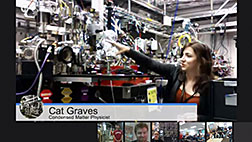- Number 409 |
- March 17, 2014
SLAC virtual field trip: Courtesy of Google+ Hangouts, YouTube and SLAC

Cat-Virtual-Field-Trip: Courtesy of Google+
Hangouts, YouTube and SLAC.
Cormac, a high school student from Journeys School in Jackson Hole, Wyoming, had a question: How does dark matter interact with regular matter? It’s a tough one; even today’s brightest physicists don’t yet completely know the answer. Fortunately, Cormac’s teacher was off the hook. Dark matter researcher Andrea Albert, connected by video from DOE's SLAC National Accelerator Laboratory, was happy to respond. “That’s a great question,” she began.
Physicists work in unique, incredible places. But students interested in science, technology, engineering or math (STEM) careers who don’t live near a laboratory may never get the opportunity to see a real-life scientist in action.
Now, thanks to Google+ Hangouts and a related Google Education program called Connected Classrooms, several of the nation’s most renowned physics labs are offering students “virtual field trips.” Through these visits, they can see inside facilities and ask experts questions.
SLAC was the third of four national labs to participate in Connected Classrooms, including Jefferson Lab, Argonne and Berkeley Lab.
“Our basic idea with Connected Classrooms was that in many cases classes face both logistical and financial challenges to going on field trips,” says Lisa Jiang, who works on the Google+ Education and STEM team. “So we thought: Why don’t we use Hangouts to bring field trips to them?”
And while seeing a lab through a computer screen isn’t quite the same as experiencing it in person, the virtual field trips benefit because it’s much easier to bring a laptop into many labs than it is to bring a class full of students. At their core, the virtual tours offer a practical, real-world perspective on STEM careers and dispel inaccurate notions people may have of what the Department of Energy’s national labs do, Jiang says.
In February, SLAC National Accelerator Laboratory hosted a virtual field trip for two high schools: one in Jackson Hole, Wyoming, and the other in Jeffersonville, Indiana. The field trip included a particle accelerator expert showing off the disappearing vantage point of SLAC’s 2-mile-long linear accelerator, a condensed matter physicist pointing out a chamber where samples are blasted with high-energy pulses from the Linac Coherent Light Source X-ray laser, and Andrea Albert, the astrophysicist mentioned earlier, surrounded by the blinking lights of an array that simulates data for the Large Area Telescope onboard NASA’s Fermi Gamma-ray Space Telescope.
This was the third virtual field trip for Katie Hutchinson, an eLearning coach who works with Jeffersonville High School. “There is something completely exciting, even as an adult, about watching events unfold live,” Hutchinson says. “But even more, it makes the world a smaller place. I think for some kids, there are jobs and places that seem unreachable. Virtual field trips help students see people in these careers and parts of the world are actually so much like them.”
In addition to connecting directly with classrooms, Google+ Hangouts are also broadcast live to the public. This means even high schools that aren’t directly in the Hangout itself can watch on Google+ and ask the scientists questions through a Q&A interface. More than 100 people joined the SLAC field trip, including a high school physics class from Caracas, Venezuela, who submitted a question about the capabilities of the linear accelerator.
The virtual field trips are also recorded and available immediately afterward on YouTube (see the video of SLAC’s virtual field trip below, including the answer to Cormac’s question at the 28:46 mark).
http://www.youtube.com/watch?v=dvzT1Pz6W4YSubmitted by DOE’s SLAC National Accelerator Laboratory
